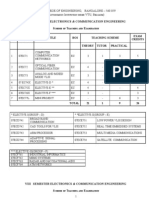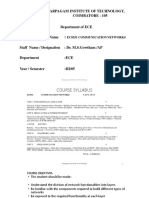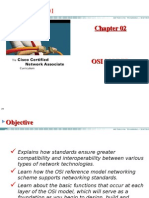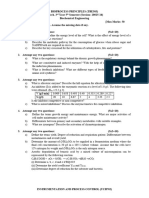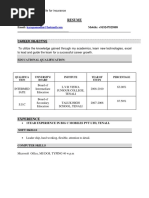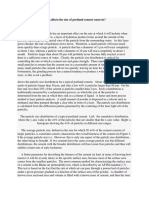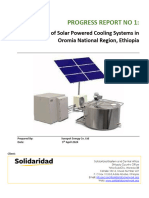ECEN 619-600 "Internet Protocols and Modeling": Instructor: Professor Xi Zhang
ECEN 619-600 "Internet Protocols and Modeling": Instructor: Professor Xi Zhang
Uploaded by
Sanjiti BhargavaCopyright:
Available Formats
ECEN 619-600 "Internet Protocols and Modeling": Instructor: Professor Xi Zhang
ECEN 619-600 "Internet Protocols and Modeling": Instructor: Professor Xi Zhang
Uploaded by
Sanjiti BhargavaOriginal Title
Copyright
Available Formats
Share this document
Did you find this document useful?
Is this content inappropriate?
Copyright:
Available Formats
ECEN 619-600 "Internet Protocols and Modeling": Instructor: Professor Xi Zhang
ECEN 619-600 "Internet Protocols and Modeling": Instructor: Professor Xi Zhang
Uploaded by
Sanjiti BhargavaCopyright:
Available Formats
ECEN 619-600 “Internet Protocols and
Modeling”
Course Materials: Papers, Reference Texts: Bertsekas/Gallager, Stuber, Stallings, etc
Grading (Tentative): HW: 20%, Projects: 40%, Exam-1:20%, Exam-II:20%
Lecture notes and Paper Reading Lists: available on-line: TBA
Class Website: http://ece.tamu.edu/~xizhang/ECEN619/start.php
Research Interests and Projects: URL:http://ece.tamu.edu/~xizhang
Instructor: Professor Xi Zhang
E-mail: xizhang@ece.tamu.edu
Office: WERC 331
ECEN 619, Internet Protocols & Modeling Prof. Xi Zhang
TCP Closed-loop flow control and “Self-Clocking”
Principle-1
ECEN 619, Internet Protocols & Modeling Prof. Xi Zhang
TCP Closed-loop flow control and “Self-Clocking”
Principle-2
• Sender sends packets back-to-back to receiver
• The vertical line is bandwidth
• The horizontal line is time
• Each of shaded box is a packet
• Bandwidth * Time = Bits, and so the area of each box is
the packet size.
• The number of bits doesn‘t change as a packet goes
through the network so a packet squeezed into the smaller
long-haul bandwidth must spread out in time.
ECEN 619, Internet Protocols & Modeling Prof. Xi Zhang
TCP Closed-loop flow control and “Self-Clocking”
Principle-3
• The time Pb represents the minimum packet spacing on the
slowest link in the path (the bottleneck).
• As the packets leave the bottleneck for the destination net,
nothing changes the inter packet interval so on the
receiver’s net packet spacing Pr = Pb.
• If the receiver processing time is the same for all packets,
the spacing between ACKs on the receiver’s net Ar = Pr =
Pb.
ECEN 619, Internet Protocols & Modeling Prof. Xi Zhang
TCP Closed-loop flow control and “Self-Clocking”
Principle
• If the time slot Pb was big enough for a packet, it’s
big enough for an ACK so the ACK spacing is
preserved along the return path. Thus the ACK
spacing on the sender’s net As= Pb.
• So, if packets after the first burst are sent only in
response to an ACK, the sender’s packet spacing
will be exactly match the packet time on the
slowest link in the path –> “Self-Clocking” is
achieved.
ECEN 619, Internet Protocols & Modeling Prof. Xi Zhang
Two versions of TCP Protocols
• TCP-tahoe (Jacobson, 1988)
– Time-out based protocol - use timeout to detect packet
loss and congestions
• TCP-reno (Jacobson, 1990)
– Triple-ACK and time-out based - Use triple-duplicate
ACK to same sequence number and timeouts to detect
packet loss and congestions
– Use fast retransmissions and fast recovery
• Skip Slow Start phase
ECEN 619, Internet Protocols & Modeling Prof. Xi Zhang
TCP-tahoe Protocol
ECEN 619, Internet Protocols & Modeling Prof. Xi Zhang
TCP-reno Protocol
ECEN 619, Internet Protocols & Modeling Prof. Xi Zhang
Slide 2 of 33
ECEN 619, Internet Protocols & Modeling Prof. Xi Zhang
Slide 3 of 33
ECEN 619, Internet Protocols & Modeling Prof. Xi Zhang
Slide 4 of 33
ECEN 619, Internet Protocols & Modeling Prof. Xi Zhang
Slide 5 of 33
ECEN 619, Internet Protocols & Modeling Prof. Xi Zhang
Slide 6 of 33
ECEN 619, Internet Protocols & Modeling Prof. Xi Zhang
Slide 7 of 33
ECEN 619, Internet Protocols & Modeling Prof. Xi Zhang
Slide 8 of 33
ECEN 619, Internet Protocols & Modeling Prof. Xi Zhang
Slide 9 of 33
ECEN 619, Internet Protocols & Modeling Prof. Xi Zhang
Slide 10 of 33
ECEN 619, Internet Protocols & Modeling Prof. Xi Zhang
Slide 11 of 33
ECEN 619, Internet Protocols & Modeling Prof. Xi Zhang
Slide 12 of 33
ECEN 619, Internet Protocols & Modeling Prof. Xi Zhang
TCP protocol control variable
• Bandwidth: m in packets/sec,
• Service time: 1/m
• Round Trip Time (RTT): T sec
• Buffer size: B in packets
• Path pipeline capacity:
Wpipe = m*T+B+1
ECEN 619, Internet Protocols & Modeling Prof. Xi Zhang
TCP/IP Layers: 5-Layer Protocol Model
• 1) Physical layer
• 2) Network access layer
• 3) Internet layer
• 4) Host-to-host, or transport layer
• 5) Application layer
ECEN 619, Internet Protocols & Modeling Prof. Xi Zhang
TCP/IP Physical Layer
• Covers the physical interface between a
data transmission device and a
transmission medium or network
• Physical layer specifies:
– Characteristics of the transmission medium
– The nature of the signals
– The data rate
– Other related matters
ECEN 619, Internet Protocols & Modeling Prof. Xi Zhang
TCP/IP Network Access Layer
• Concerned with the exchange of data
between an end system and the network to
which it's attached
• Software used depends on type of network
– Circuit switching
– Packet switching (e.g., X.25)
– LANs (e.g., Ethernet)
– Others
ECEN 619, Internet Protocols & Modeling Prof. Xi Zhang
TCP/IP Internet Layer
• Uses internet protocol (IP)
• Provides routing functions to allow data to
traverse multiple interconnected networks
• Implemented in end systems and routers
ECEN 619, Internet Protocols & Modeling Prof. Xi Zhang
TCP/IP Host-to-Host, or
Transport Layer
• Commonly uses transmission control
protocol (TCP)
• Provides reliability during data exchange
– Completeness
– Order
ECEN 619, Internet Protocols & Modeling Prof. Xi Zhang
TCP/IP Application Layer
• Logic supports user applications
• Uses separate modules that are peculiar to
each different type of application
ECEN 619, Internet Protocols & Modeling Prof. Xi Zhang
Protocol Data Units (PDUs)
ECEN 619, Internet Protocols & Modeling Prof. Xi Zhang
TCP Header Format
ECEN 619, Internet Protocols & Modeling Prof. Xi Zhang
IP Header Format-1: IPv4 Header
ECEN 619, Internet Protocols & Modeling Prof. Xi Zhang
IP Header Format-2: IPv6 Header (Newer
Version since 1995)
ECEN 619, Internet Protocols & Modeling Prof. Xi Zhang
Common TCP/IP Applications
• Simple mail transfer protocol (SMTP)
– Provides a basic electronic mail facility
• File Transfer Protocol (FTP)
– Allows files to be sent from one system to
another
• TELNET
– Provides a remote logon capability
ECEN 619, Internet Protocols & Modeling Prof. Xi Zhang
Service Access Point (SAP) under TCP/IP
Concepts
ECEN 619, Internet Protocols & Modeling Prof. Xi Zhang
Internetworking Terms
• Communication network – facility that provides a data
transfer service among devices attached to the network
• Internet – collection of communication networks,
interconnected by bridges/routers
• Intranet – internet used by an organization for internal
purposes
– Provides key Internet applications
– Can exist as an isolated, self-contained internet
ECEN 619, Internet Protocols & Modeling Prof. Xi Zhang
Internetworking Terms
• End System (ES) – device used to support end-
user applications or services
• Intermediate System (IS) – device used to
connect two networks
• Bridge – an IS used to connect two LANs that
use similar LAN protocols
• Router - an IS used to connect two networks
that may or may not be similar (such as WAN
and LAN)
ECEN 619, Internet Protocols & Modeling Prof. Xi Zhang
Functions of a Router
• Provide a link between networks
• Provide for the routing and delivery of data
between processes on end systems attached
to different networks
• Provide these functions in such a way as not
to require modifications of the networking
architecture of any of the attached sub-
networks
ECEN 619, Internet Protocols & Modeling Prof. Xi Zhang
An Example of Router Applications
ECEN 619, Internet Protocols & Modeling Prof. Xi Zhang
Network Differences Routers
Must Accommodate
• Addressing schemes
– Different schemes for assigning addresses
• Maximum packet sizes
– Different maximum packet sizes requires segmentation
• Interfaces
– Differing hardware and software interfaces
• Reliability
– Network may provide unreliable service
ECEN 619, Internet Protocols & Modeling Prof. Xi Zhang
You might also like
- National Aerospace Standard: 12 Completely RevisedDocument4 pagesNational Aerospace Standard: 12 Completely RevisedGlenn CHOU75% (4)
- Ospf Network Analyzing Using OmnetDocument97 pagesOspf Network Analyzing Using OmnetIlaria Curcuglioniti100% (1)
- ECEN 619-600 "Internet Protocols and Modeling": Instructor: Professor Xi ZhangDocument18 pagesECEN 619-600 "Internet Protocols and Modeling": Instructor: Professor Xi ZhangSanjiti BhargavaNo ratings yet
- ECEN 619-600 "Internet Protocols and Modeling"Document24 pagesECEN 619-600 "Internet Protocols and Modeling"Sanjiti BhargavaNo ratings yet
- Internet History and Architectural Principles: Advanced Computer NetworksDocument34 pagesInternet History and Architectural Principles: Advanced Computer NetworksPankaj P Raibagkar JainNo ratings yet
- Slide-2-TCP-IP ModelDocument11 pagesSlide-2-TCP-IP ModelRobbie SolimanNo ratings yet
- 19EC412 - Communication NetworksDocument4 pages19EC412 - Communication NetworksAbi JayanNo ratings yet
- Computer NetworksDocument10 pagesComputer Networkspaperprep3No ratings yet
- DCN Practical File 2024Document90 pagesDCN Practical File 2024mritunjayp8140No ratings yet
- CN AssiDocument9 pagesCN AssivkrNo ratings yet
- Comparative Analysis of OSI and TCP/IP Models in Network Communication.Document7 pagesComparative Analysis of OSI and TCP/IP Models in Network Communication.Kelvin NnamaniNo ratings yet
- CN lab manual (3)Document99 pagesCN lab manual (3)mallickgaurang321No ratings yet
- Managing Networks and Telecommunications: Backbone Network DesignDocument16 pagesManaging Networks and Telecommunications: Backbone Network DesignBang Ho SiNo ratings yet
- Slide 3 Networking Concepts Lecture 1 AeditedDocument42 pagesSlide 3 Networking Concepts Lecture 1 AeditedShiela JusNo ratings yet
- TesfayDocument5 pagesTesfayAklilu AbrhaNo ratings yet
- CNS Lab ManualDocument67 pagesCNS Lab ManualVaibhav DikeNo ratings yet
- Scalability Evaluation of VOIP Over Various MPLS Tunneling Under OPNET ModelerDocument8 pagesScalability Evaluation of VOIP Over Various MPLS Tunneling Under OPNET ModelerveterfveNo ratings yet
- CCN Syllabus BAMU ETCDocument2 pagesCCN Syllabus BAMU ETCanilbNo ratings yet
- 371CCS-3 Lab ManualDocument49 pages371CCS-3 Lab ManualalamritdydydNo ratings yet
- LM Computernetworks Shortsize (1.3)Document118 pagesLM Computernetworks Shortsize (1.3)Divine Krystelle SumagaysayNo ratings yet
- Comparative Analysis of OSI and TCPIP Models in Network CommunicationDocument8 pagesComparative Analysis of OSI and TCPIP Models in Network CommunicationOgwugwuam EzeagwuNo ratings yet
- 7th & 8th Sem SyllabusDocument33 pages7th & 8th Sem SyllabusAkshay BharadwajNo ratings yet
- Medi-Caps University 2020-2021Document11 pagesMedi-Caps University 2020-2021Krati ChhabraNo ratings yet
- The OSI and TCPDocument8 pagesThe OSI and TCPSreejith VaneryNo ratings yet
- Karpagam Institute of Technology, Coimbatore - 105: Ec8551 Communication NetworksDocument252 pagesKarpagam Institute of Technology, Coimbatore - 105: Ec8551 Communication NetworksKarthik Sara MNo ratings yet
- Transmission Control Protocol07Document11 pagesTransmission Control Protocol07chaudhary1992No ratings yet
- Chapter 9 - Ethernet: CCNA Exploration 4.0Document90 pagesChapter 9 - Ethernet: CCNA Exploration 4.0kiennaNo ratings yet
- Final IEEE StandardDocument4 pagesFinal IEEE StandardAhmed Bahig MohamedNo ratings yet
- In This Issue: September 2000 Volume 3, Number 3Document52 pagesIn This Issue: September 2000 Volume 3, Number 3aqua01No ratings yet
- CryptographyDocument13 pagesCryptographythasuplysmNo ratings yet
- Network Applications U2Document52 pagesNetwork Applications U2hdriNo ratings yet
- Chapter 8 Communication ProtocolsDocument23 pagesChapter 8 Communication Protocolsarnel vence l. zarzaNo ratings yet
- "Internet Protocol": A Report OnDocument32 pages"Internet Protocol": A Report Onsupriyaverma1989No ratings yet
- Abstract PublikasiDocument1 pageAbstract PublikasiYusfi MalayusfiNo ratings yet
- 1 SyllabusDocument3 pages1 SyllabusThumma ReddyNo ratings yet
- Full Text 01Document83 pagesFull Text 01Marina CzuprynaNo ratings yet
- CCNA-Internship PresentationDocument19 pagesCCNA-Internship Presentationshiva sai donthulaNo ratings yet
- Smansub - 2019 - J. - Phys. - Conf. - Ser. - 1195 - 012019 ARBOL DE COLAS ADMINISTRACION DE BANDA MIKROTIKDocument6 pagesSmansub - 2019 - J. - Phys. - Conf. - Ser. - 1195 - 012019 ARBOL DE COLAS ADMINISTRACION DE BANDA MIKROTIKTony CervantesNo ratings yet
- CCNAv3.3 102Document45 pagesCCNAv3.3 102Tung HoangNo ratings yet
- Methodology: (CITATION 5be20 /L 1033) (CITATION Net203 /L 1033)Document2 pagesMethodology: (CITATION 5be20 /L 1033) (CITATION Net203 /L 1033)ammad ahmadNo ratings yet
- dcfb22f6-50df-4f59-9800-8eb3677c936fDocument3 pagesdcfb22f6-50df-4f59-9800-8eb3677c936fkhaledrousan5151No ratings yet
- CN Lab ManualDocument45 pagesCN Lab ManualHanumanthu Mothukuru100% (1)
- TCP/IP Model PresentationDocument11 pagesTCP/IP Model PresentationArpitmaan100% (1)
- CS 1305 - Network Lab ManualDocument54 pagesCS 1305 - Network Lab ManualYeswanth PrabuNo ratings yet
- OSI and TCP/IP ModelDocument35 pagesOSI and TCP/IP ModelSwapnil agrawalNo ratings yet
- LAN Simulation Using CISCO Packet TracerDocument10 pagesLAN Simulation Using CISCO Packet TracerRathaNo ratings yet
- Internet Technologies: Mbeya University of Science and TechnologyDocument44 pagesInternet Technologies: Mbeya University of Science and TechnologyKAMBAULAYA NKANDANo ratings yet
- H05 CSC458 Tutorial IIDocument16 pagesH05 CSC458 Tutorial IIDUDEKULA VIDYASAGARNo ratings yet
- CA Ex S1M09 EthernetDocument136 pagesCA Ex S1M09 Ethernethttp://heiserz.com/No ratings yet
- TCP / Ip Module Suite and Architectures: April 2018Document13 pagesTCP / Ip Module Suite and Architectures: April 2018maryjoy corpuzNo ratings yet
- Welcome To The World of Networking: CISCO Certification SystemDocument48 pagesWelcome To The World of Networking: CISCO Certification SystemQuan DaoNo ratings yet
- Computer Network No.1 (Introduction) From APCOMSDocument36 pagesComputer Network No.1 (Introduction) From APCOMSNaveed100% (2)
- CN Lab ManualDocument81 pagesCN Lab ManualbhaveshNo ratings yet
- Important Portions m1 m2 CNDocument63 pagesImportant Portions m1 m2 CNhamdhanNo ratings yet
- CN SyllabusDocument3 pagesCN Syllabustanmay sonawaneNo ratings yet
- Bcse308l Computer-Networks TH 1.0 70 Bcse308lDocument2 pagesBcse308l Computer-Networks TH 1.0 70 Bcse308ldsa dsaNo ratings yet
- UNIT 1 AKTU Last Five Year Solutions - Computer Networks - (KCS-603)Document15 pagesUNIT 1 AKTU Last Five Year Solutions - Computer Networks - (KCS-603)mayushbbk18No ratings yet
- Bandwidth Allocation for Video under Quality of Service ConstraintsFrom EverandBandwidth Allocation for Video under Quality of Service ConstraintsNo ratings yet
- TCP/IP: Network+ Protocols And Campus LAN Switching FundamentalsFrom EverandTCP/IP: Network+ Protocols And Campus LAN Switching FundamentalsNo ratings yet
- The Effects of Traffic Structure on Application and Network PerformanceFrom EverandThe Effects of Traffic Structure on Application and Network PerformanceNo ratings yet
- The Compete Ccna 200-301 Study Guide: Network Engineering EditionFrom EverandThe Compete Ccna 200-301 Study Guide: Network Engineering EditionRating: 5 out of 5 stars5/5 (4)
- India: No.30/0/2018 Government The Director General Central Public Works DepartmentDocument53 pagesIndia: No.30/0/2018 Government The Director General Central Public Works DepartmentChief Engineer Western Zone-3No ratings yet
- Sample ContractsDocument17 pagesSample ContractsfdgdssdNo ratings yet
- Bioprocess Principles & Ipc QPDocument2 pagesBioprocess Principles & Ipc QPmayank kushwahaNo ratings yet
- Organic Chemistry Assignment 1Document2 pagesOrganic Chemistry Assignment 1Jimmy YungNo ratings yet
- Fastener Manufacturers in IndiaDocument8 pagesFastener Manufacturers in IndiaKaloti IndiaNo ratings yet
- DC80Document13 pagesDC80Rier AssistenciaNo ratings yet
- Research Paper On Team DynamicsDocument4 pagesResearch Paper On Team Dynamicsjsxmwytlg100% (1)
- UBA Bank StatementDocument1 pageUBA Bank StatementoriyabelleNo ratings yet
- Module 2 Blood, Semen and DNA AnalysisDocument19 pagesModule 2 Blood, Semen and DNA AnalysisLaw RenceNo ratings yet
- Cx. Vel. 12 As 2301 ItDocument72 pagesCx. Vel. 12 As 2301 ItClaudemiro CostaNo ratings yet
- Growth Strategy Ansoff MatrixDocument4 pagesGrowth Strategy Ansoff MatrixAndrea Demos StylesNo ratings yet
- Madhu Karapa - GunturDocument2 pagesMadhu Karapa - GunturDinesh KumarNo ratings yet
- Spelling Bee - SynthDocument149 pagesSpelling Bee - Synthplanetinhas9No ratings yet
- Sheet Metal Working PDFDocument75 pagesSheet Metal Working PDFKainat jamilNo ratings yet
- Homework Incentives For Middle School StudentsDocument5 pagesHomework Incentives For Middle School Studentscff4ez15100% (1)
- 2009 UPLB Annual ReportDocument32 pages2009 UPLB Annual ReportUPLB Office of the Vice Chancellor for Research and ExtensionNo ratings yet
- Empires Between Islam and Christianity, 1500-1800 Sanjay Subrahmanyam All Chapter Instant DownloadDocument33 pagesEmpires Between Islam and Christianity, 1500-1800 Sanjay Subrahmanyam All Chapter Instant Downloadlezqinyldrm100% (2)
- Lisa Martin - Augmentative and Alternative Communication - EnglishDocument37 pagesLisa Martin - Augmentative and Alternative Communication - EnglishGlobalDownSyndromeNo ratings yet
- How Does The Particle Size Affects The Size of Portland Cement Concrete?Document4 pagesHow Does The Particle Size Affects The Size of Portland Cement Concrete?Madriaga RayNo ratings yet
- Revision Question Mid Semester Exam (Lecturer Copy)Document14 pagesRevision Question Mid Semester Exam (Lecturer Copy)ntyn1904No ratings yet
- Korando Ewd CewdDocument192 pagesKorando Ewd CewdsatthatNo ratings yet
- B2B Global Public Goods ChinDocument2 pagesB2B Global Public Goods ChinTiago GonçalvesNo ratings yet
- Seohyun & Yonghwa - Banmal SongDocument4 pagesSeohyun & Yonghwa - Banmal SongIngvar Estorco Jr67% (3)
- CLAIRE Is It Really LoveDocument287 pagesCLAIRE Is It Really LoveDănuța Vatră0% (1)
- Projectile MotionDocument58 pagesProjectile Motionrain diapoletNo ratings yet
- Candy!: It's Dandy:)Document16 pagesCandy!: It's Dandy:)nabila OktavianiNo ratings yet
- Business Proposal Letter To ClientDocument3 pagesBusiness Proposal Letter To ClientharshitNo ratings yet
- Flow ElementsDocument5 pagesFlow ElementsAnupam MudlyNo ratings yet
- Progress - Report - On - The - Installation - of - Solar Milk Coolers - ODFB Project, EthiopiaDocument9 pagesProgress - Report - On - The - Installation - of - Solar Milk Coolers - ODFB Project, EthiopiaSheila KorirNo ratings yet





















